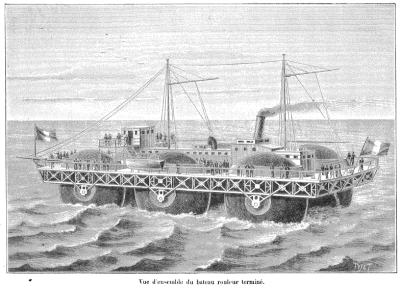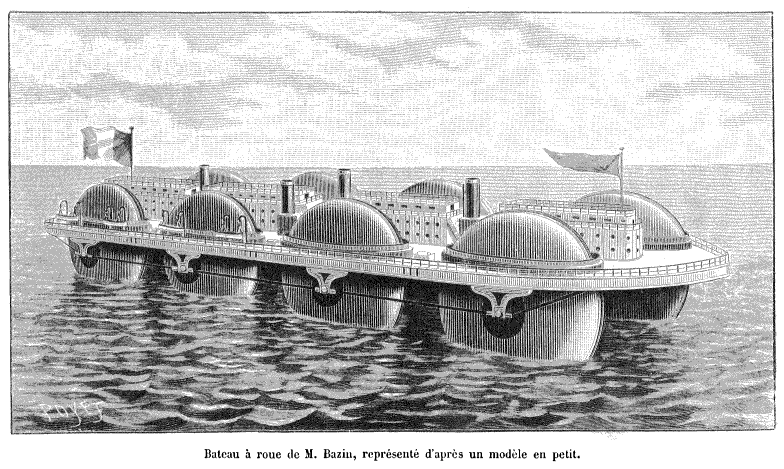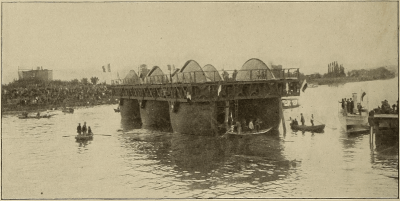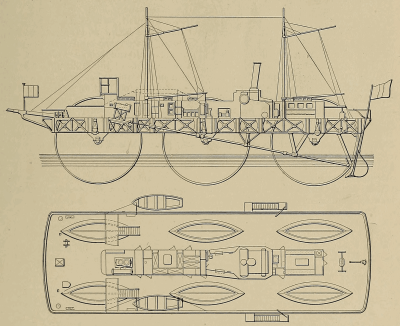THE ROLLER SHIP WAS NOT AN EFFECTIVE WAY TO CROSS THE HIGH SEAS
Boats come in all shapes and sizes. We have container ships, oil tankers, old-timey wooden sailing ships, catamarans, trimarans, and all sorts besides. Most are designed with features that give them a certain advantage or utility that justifies their construction for a given application.
The roller ship, on the other hand, has not justified its own repeat construction. Just one example was ever built, which proved unseaworthy and impractical. Let’s explore this nautical oddity and learn about why it didn’t make waves as its inventor may have hoped.
FLOATER
Bazin’s roller ship at launch in St. Denis, France, as seen in the February 1897 edition of Cassier’s Magazine. Credit: public domain
The basic idea of the roller ship was to get much of the ship’s body out of the water. This part of the concept was sound. Contact with the water creates a great deal of drag on a ship, so reducing the amount of the boat in the water would enable it to travel much faster. Many designs, like catamarans and hydrofoils, have cut drag by reducing the wetted area of the boat, and done so effectively. The roller ship, however, didn’t do it so well.
The roller ship used a number of large rollers on either side of the boat. Each roller was disc shaped, and tapered radially, having a vaguely lens-like shape. The rollers were hollow, and intended to provide floatation for the craft and propulsion. When stationary, the discs were essentially like a skinny hull. However, the rollers could be driven akin to large wheels on a road-going craft, which provided some forward drive. The roller ship design also featured a screw drive to aid in propulsive efforts.

The Ernest-Bazin roller ship, as depicted in La Nature, 1897. Credit: public domain
Just one roller ship was ever built and made operational. French inventor Ernest Bazin built a working craft in 1896, naming it after himself. Weighing in at over 200 tons It was the culminating result of five years spent testing models to explore the concept. The craft featured six large rollers, three on each side. The rollers were driven in pairs, with each axle having a 50 horsepower engine. It was a large and imposing craft, some 40 meters long and 12 meters wide, with the main hull standing 4 meters above sea level.
The general hope was that the roller ship would slash travel times by virtue of its low-drag design. Sadly, an attempt to cross the English Channel in 1897 revealed that the roller design had one unforeseen drawback. In the water, the rollers tended to drag a great deal of water up with them as they rotated. Rather than turning quickly, the rollers labored and the craft could barely break a dozen miles an hour according to a contemporary account. Even for the late 19th century, that was slow.
A depiction of the roller ship concept in Cassier’s Magazine, 1897. The idea of a faster way to cross the ocean had enough value back then that it excited interest on both sides of the Atlantic. Credit: public domain
Bazin wasn’t deterred, and later claimed to have solved the problems of the design. Sadly, he would pass away a short time later in 1898, leaving behind unfinished plans for an eight-disc ocean liner he believed could cross from Le Havre, France to New York in just 60 hours.
Ultimately, the roller ship was a mechanically complicated concept with no real benefit. Putting rollers in water didn’t make a craft more capable than simply designing a boat with narrow fixed hulls and a more traditional propulsion system. Beyond that, the hydrofoil would prove a far more useful way of cutting drag for ships with far less fuss. There are also questions around how stable the ship could possibly be with such a high center of gravity, with much of the weight sticking so high out of the water.
And yet, like so many other fanciful designs, it captured hearts and minds along the way. It ended up depicted in all kinds of media, showing up everywhere from Nature to Scientific American. And we still remember its example today! It’s proof of how much we appreciate an oddball design, even if it has no practical value whatosever.


